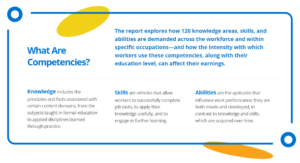A November report by the Georgetown University Center on Education and the Workforce (CEW) highlights the skills, knowledge, and abilities that have the highest value in the American workforce.
The report used data from the Occupational Information Network, a database updated regularly by the US Department of Labor to analyze the requirements associated with more than 1,000 occupations in the American labor market. CEW used this data to calculate demand and intensity of use for each competency.
Click images to enlarge
The report pinpointed five cognitive competencies that are in high demand across all occupational groups: (1) communication, (2) teamwork, (3) sales and customer service, (4) leadership, and (5) problem solving and complex thinking. The report also found that over the last 50 years, due to shifts in the economy from technological advances, the demand for physical competencies in the workforce has fallen, while the need for cognitive competencies has risen.
Having in-demand competencies are valuable: the report finds that in addition to a worker’s education level, the intensity in which workers use these competencies within a job results in an earnings premium compared to those who do not. There is additionally a strong association between educational attainment and having a job that requires intensive use of in-demand competencies. For example, 77% of the workers who use communication – the most in-demand competency across every occupation – have a bachelor’s degree or higher. And workers who use communication with higher intensity in their jobs see an increased earnings premium.
 Use of in-demand competencies can also help workers with lower levels of education earn more. For example, for workers in blue-collar occupations, higher levels of formal education may only lead to a small earnings boost, but having in-demand competencies like problem solving can enable workers with less education to earn more than their peers with more education. However, possessing postsecondary degrees and experience are a way for workers to show information about their competencies to potential employers.
Use of in-demand competencies can also help workers with lower levels of education earn more. For example, for workers in blue-collar occupations, higher levels of formal education may only lead to a small earnings boost, but having in-demand competencies like problem solving can enable workers with less education to earn more than their peers with more education. However, possessing postsecondary degrees and experience are a way for workers to show information about their competencies to potential employers.
Of course, the labor market rewards distinct mixes of competencies and education depending on what workers need within certain jobs. Different combinations of competencies may pay off in different occupations. But the report is clear: in addition to specific competencies workers need for their occupations, the top competencies listed above pay off for all occupational groups.
This report is illustrative today as the state and country grapple with economic difficulties due to the pandemic. Generally, economic hard times speed up automation: workers whose jobs can be done by machines are more likely to be laid off. In contrast, jobs that require flexibility or judgement are difficult to automate. With an unknown economic future ahead, the study suggests general competencies that are transferable across multiple occupations are a valuable investment for workers. Certain general competencies such as leadership are timeless.
There are several important takeaways from this report for education and workforce stakeholders. Students and workers can use this information to inform their choices about their training and education needs. In the pandemic era, when workers may be seeking upskilling, they should look to develop competencies that are in high demand and rewarded within their chosen occupation. Employers can use this information to communicate about which competencies workers need in certain occupations, while educators can use it to best prepare students for work. Importantly, policymakers can use it to develop a better understanding of the competencies that have the greatest demand and reward.
RELATED ARTICLES:
Dr. Aysegul Timur is helping build foundational skills in SWFL
Georgetown report urges states to help students make more informed college and career decisions

